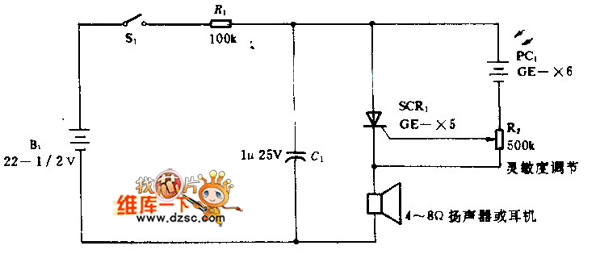
Light sensing circuit diagram

In the silicon-controlled trigger circuit, a cadmium sulfide cell is connected to a relaxation oscillator, which serves as a sensor to activate a blinking light in a darkroom. This setup causes a speaker to emit a warning sound of Ka, Li. The frequency of the sound increases with the amount of light detected. In the absence of blinking, R2 is adjusted to a value lower than the threshold that controls the sound output.
The silicon-controlled trigger circuit utilizes a cadmium sulfide (CdS) cell, which is a light-dependent resistor that changes its resistance based on the ambient light level. This property is exploited in the design to create a responsive system that reacts to variations in light intensity. The CdS cell is integrated with a relaxation oscillator, which generates a periodic signal. This oscillator is essential for creating the blinking effect in a dark environment.
When light levels are sufficient, the resistance of the CdS cell decreases, allowing more current to flow through the circuit. This increase in current triggers the relaxation oscillator, which in turn activates the speaker to produce the warning sound. The sound emitted is characterized by the frequencies Ka and Li, which can serve as alerts for specific conditions or events.
The modulation of resistor R2 plays a critical role in controlling the sound output. If the system detects that there is no blinking light (indicating low ambient light conditions), R2 can be adjusted to ensure that the resistance falls below a certain threshold. This adjustment is crucial because it allows the circuit to maintain functionality and responsiveness even in varying light conditions. By lowering R2, the circuit can ensure that the sound output remains at a manageable level, preventing excessive noise in a quiet environment.
In summary, the silicon-controlled trigger circuit with a CdS cell and relaxation oscillator forms an effective light-sensing mechanism that not only provides visual feedback through blinking but also auditory warnings through sound modulation, making it suitable for applications requiring alert systems in low-light conditions.In the silicon-controlled trigger circuit, cadmium sulfide cell connects the relaxation oscillator before having a sensor to blink in darkroom. That make the speaker emit the warning sound of Ka, Li. The rate of the sound will increase with the quantity of light. When there is no blink, to modulate R2 until it`s lower than the limiting value of sound. The.. 🔗 External reference
The silicon-controlled trigger circuit utilizes a cadmium sulfide (CdS) cell, which is a light-dependent resistor that changes its resistance based on the ambient light level. This property is exploited in the design to create a responsive system that reacts to variations in light intensity. The CdS cell is integrated with a relaxation oscillator, which generates a periodic signal. This oscillator is essential for creating the blinking effect in a dark environment.
When light levels are sufficient, the resistance of the CdS cell decreases, allowing more current to flow through the circuit. This increase in current triggers the relaxation oscillator, which in turn activates the speaker to produce the warning sound. The sound emitted is characterized by the frequencies Ka and Li, which can serve as alerts for specific conditions or events.
The modulation of resistor R2 plays a critical role in controlling the sound output. If the system detects that there is no blinking light (indicating low ambient light conditions), R2 can be adjusted to ensure that the resistance falls below a certain threshold. This adjustment is crucial because it allows the circuit to maintain functionality and responsiveness even in varying light conditions. By lowering R2, the circuit can ensure that the sound output remains at a manageable level, preventing excessive noise in a quiet environment.
In summary, the silicon-controlled trigger circuit with a CdS cell and relaxation oscillator forms an effective light-sensing mechanism that not only provides visual feedback through blinking but also auditory warnings through sound modulation, making it suitable for applications requiring alert systems in low-light conditions.In the silicon-controlled trigger circuit, cadmium sulfide cell connects the relaxation oscillator before having a sensor to blink in darkroom. That make the speaker emit the warning sound of Ka, Li. The rate of the sound will increase with the quantity of light. When there is no blink, to modulate R2 until it`s lower than the limiting value of sound. The.. 🔗 External reference





